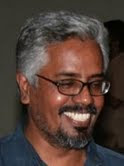RAAMANAM – ON ADAPTATION AND REVELATIONS
MP Sukumaran Nair talks about his new film Raamanam
 Raamanam is an adaptation of ‘Smarakasilakal’ the celebrated novel by
Raamanam is an adaptation of ‘Smarakasilakal’ the celebrated novel byPunathil Kunhabdulla. What were the challenges in making a film out of
a much-read novel that was written decades ago?
It was a daunting task and there were difficulties at different
levels. The novel is actually set in the 1940’s as can be guessed from
its reference to the Onchiyam incident. When you take up such a story,
one cannot mechanically reproduce it today. After Babri Masjid
demolition, one cannot conceive of the Muslim society in Keralam or a
character like Thangal in such a manner. Maybe one can take such
liberties in literature, but in a visual medium like cinema, it’d look
totally apolitical and retrogressive today..
What about the narrative style followed by Punathil?
Punathil has his own style that is very readable. But though he is
descriptive in a sensual way and very articulate about sensual
aspects, he does not give us many visual clues. Moreover, I had to
visualize a milieu with which I was not very acquainted.His
descriptions about life in the Thangal family indicate a big joint
family, but character-wise, it looks like a small family. Thangal’s
relationship with Neeli itself is very ambiguous. All this made the
task of fixing the visual coordinates arduous. But Punathil’s novel is
rich with stories about people, places, incidents etc. I have drawn
this aspect into the film.
 still from Raamanam
still from RaamanamYou’ve placed your narrative in the period between 1970 and 1990’s.
How and why did you’ re-historicize’ the narrative?
The novel is apparently set in the 1940’s when independence struggle
was raging all over. But the only indication of this is the mention
about Onchiyam incident. Historically, I begin the narrative of the
film in the 1970’s when a split occurs within the Muslim League with
one faction moving closer to the left. You can see that Thangal
belongs to the pro-left faction, and so, the film traverses that
historical trajectory followed by two other historical moments: the
Emergency and Babri Masjid demolition. That is how I structured the
narrative time of the film.
Thangal is more of a libertine in the novel and his sexual escapades
are numerous and dominant…
One cannot possibly portray him like that now. If I do so, it will
distort the very image of the community and can lead to dangerous
readings in the present context. For instance, a scholar who had done
research on the novel told me that the violent death he meets with in
the end was in a way a punishment to his actions in life. But my
attitude to this character was different; I didn’t want to portray him
like that, especially now. Despite everything, he has a certain kind
of eccentricity in him, which prompts him to give refuge to Neeli,
adopt her son as his own, educate him and his daughter, and teach the
latter an art like Nangiarkoothu etc. He is not a normal person in
that sense. All this places him in a very different manner in the film
narrative.
But there is a strong thread of goodness running through the novel.
For instance the personal care he takes for someone like Eramullan,
the horse, Neeli etc. It is something that defies any kind of
stereotyping. I took that element too from the novel.
In all your early films, you have worked with other contexts and
communities. How was your encounter with this milieu?
During the shooting of the film, I had the opportunity to mingle with
many people there, both men and women. I met a lot of old women who
were active in the communist party and had taken part in street
processions etc. But in the present, I felt that there is a certain
sense of insecurity running deep within the community. I don’t know
whether it is fear or anger or suspicion. This was evident in the way
local people interacted with us. Majority of them earnestly wanted to
help us in the shooting by finding locations etc but were reluctant to
do so; they seemed to be afraid of something. I felt very sad about
it, because it is not at all a healthy. It indicates the positions
into which we’ve driven a progressive community like the Muslims in
Malabar. Evidently, the Babri Masjid demolition has affected the
community in a very profound manner. So, I think its inclusion in the
film was also justified by my experience during shooting. I never
thought its repercussions were so deep..
This is also being telecast as a television serial, isn’t it?
Yes, but I shot the film and teleserial in different formats and with
two different camera setups. The serial dwells much more upon details,
subplots and other characters in the novel. But a film can’t afford
it.
Labels: malayalam cinema


0 Comments:
Post a Comment
Subscribe to Post Comments [Atom]
<< Home